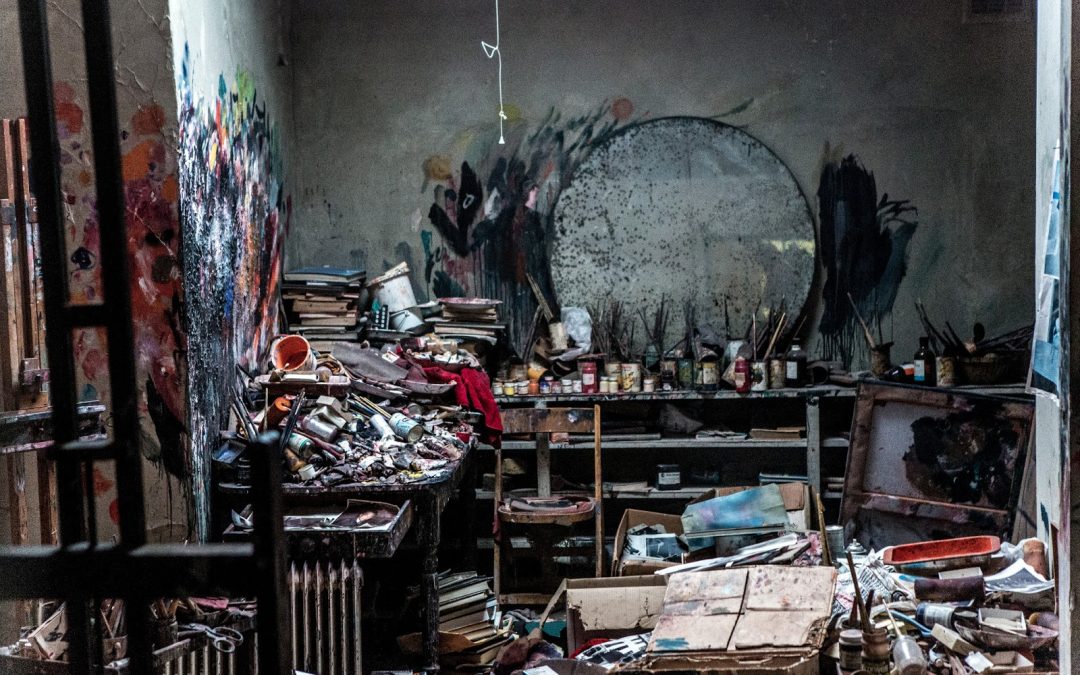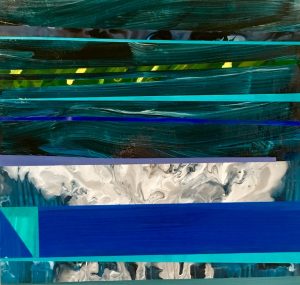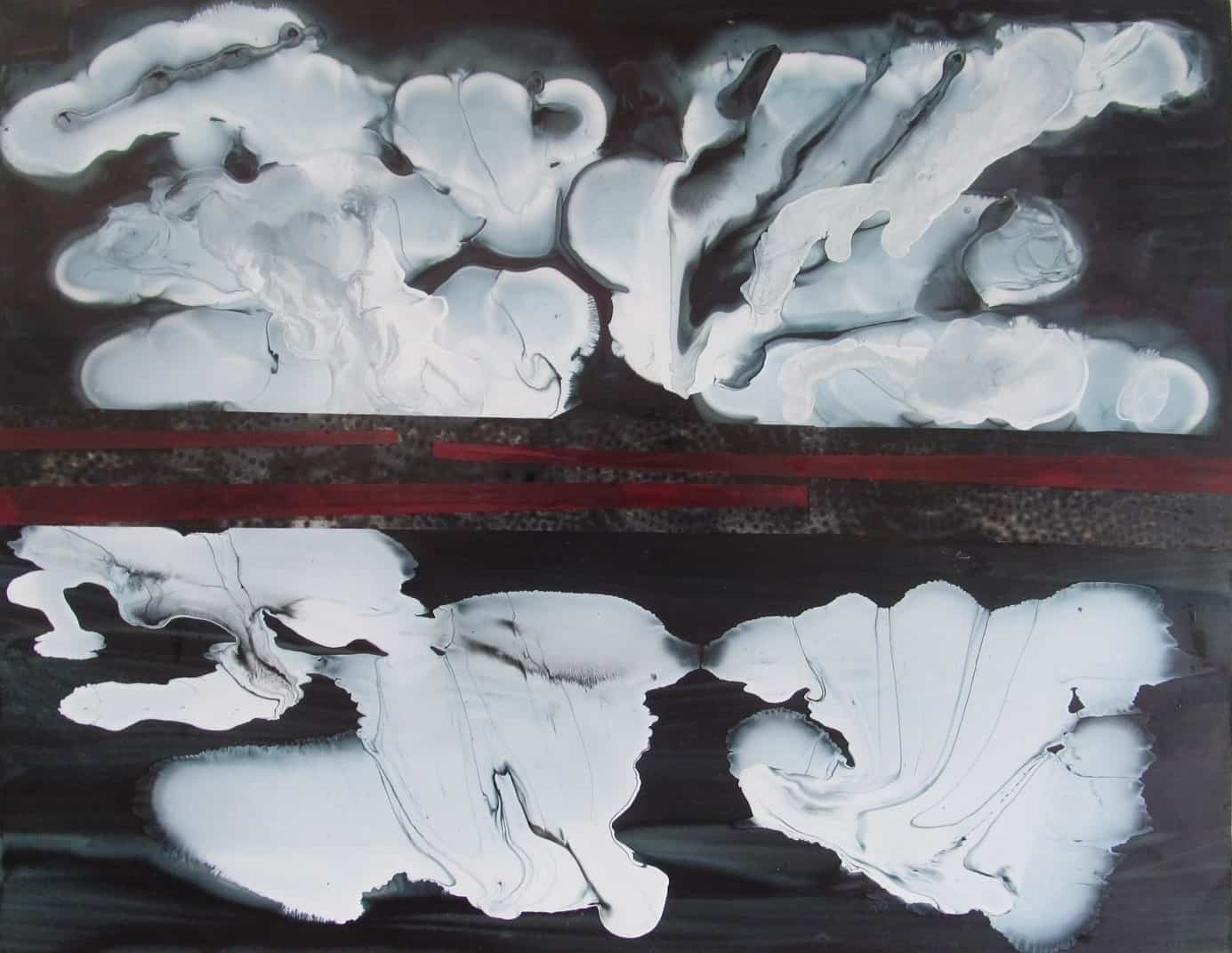Be careful whom you invite
As readers know from my adventures with a material called Dura-Lar and “Confessions of a Closet Painter,” I spend about ten hours a week in a corner of my friend TJ Mabrey’s studio, messing around with paint and affixing bits of the seductively translucent material to wood panels. It’s something more than a hobby and less than an obsession. It’s therapy, a respite from time at the computer, and, oddly (or maybe not so oddly), a way of better understanding the frustrations of real artists.
But after more than a year of concerted endeavors and experiments, I found myself going in about three or four different directions. I wanted some advice on what seemed the most promising, and so I turned to an artist friend here in Taos whose judgment I was reasonably sure I could trust.
Oh, how little we know people until we ask for an opinion!
Katrina, as I’ll call her, swept into the studio on a chilly late afternoon last month. She did not spend much time looking around before launching into a full-scale attack. She honed in on a group of four foot-square panels and turned them face down, all but one, on the shelf that supported them. “Oh, I don’t like these at all,” she said. She barely glanced at some geometric works that I’d lately started and focused instead on some landscape-y things made last summer, which I’d begun to think were rather corny.
“These are just awful,” she pronounced about some abstractions that to me had a certain appealing Asian inflection (they now hang in my ex-husband’s new house and look quite terrific…at least he and his next-door neighbor love them). “But these are rather nice,” she said of the groups of small panels (about three and four inches square) I called “Sky Boxes.” I think they’re pretty, too, but I came full-stop to a dead end and couldn’t make anymore.
“You need to mix your colors. How are you mixing your colors?” Katrina demanded. I showed her my ceramic palette with small wells for mixing the high-flow acrylics I use. “Oh, this is not right. You need to lay out your colors on a real palette.” Even though I explained that the runny paints do not lend themselves well to traditional ways of blending one color with another, she needed to see for herself and squirted out a few drops of different shades on a sheet of Dura-Lar. She used a brush to try to mix the paints, but they quickly started to dry out and you can’t really squeeze out enough paint on a flat “palette” to cover even a small surface.
After about 45 minutes of full-frontal assault, I was stunned, dazed, and confused. “Have you ever taught?” I asked her.
She looked startled and breathed in sharply. “Yes, I’ve taught at RISD and Parsons and a few other places.”
“Were you this rough on your students? Don’t you think a gentler approach would work better?”
There was no answer, but at that point I just wanted to hustle us off to the dinner we’d planned with a friend.
I couldn’t go back into the studio for a few days. And indeed I never wanted to talk to Katrina again. She later apologized, via email, explaining that she’d almost driven into a guard rail on her way over and was feeling tense and on edge. But I don’t find that sufficient excuse for what was almost bullying and disrespectful behavior.
The takeaway value of the visit for me was nil. But I did realize that if I ever do this again I will set up the work differently, group the various separate efforts together—instead of scattered about, as I had them—and ask very pointed questions. “Which of these appeals to you most?” “Which seem most promising?” “And how the hell do I find something I want to stick with for more than a few months?”
When I posted about the visit on Facebook, there was a flurry of sympathetic responses. One member of the site emailed me, saying, “Your artist friend did not give a comprehensive critique because she didn’t ask you the right questions. Good crits come with multiple views.” Others told of similarly brutal visits from art dealers or ugly attacks in art school, long distances traveled to have “experts” look at work, only to get a thumbs-down. The life of an artist, I am learning, contains more slings and arrows than acting auditions for an off-off-Broadway play.
I’ve written for ARTnews and for this site about smart ways for the artist to prepare for and conduct a studio visit. But perhaps there needs to be some sensitivity training for the other side as well. Artists, even amateurs like myself, are delicate creatures, no matter how tough the shell we try to cultivate. When asked to give some guidance and feedback, it’s not really enough to say “Oh, I like these!” or “I hate these!” without offering some explanation as to why the works succeed or fail. When I’ve done studio visits myself, I’ve been careful not to handle things without permission. I try to give a fair and articulate opinion. I would never, ever say, “This is really tired stuff” or “I can’t stand these.” That’s not helpful to the artist and reflects poorly on the visitor.
The rules of studio visits should be fairly simple. Above all, especially if you’re an artist yourself, simply abide by the Golden Rule: “Do unto others….”
You know the rest.
Ann Landi
Top: Frances Bacon’s studio. Not mine. Thank God.






It is brave to ask for someone to really look at your work and it is difficult when there isn’t the approval one hopes for. Getting the ‘where next’ ideas flowing is really tricky with other people and I have found that this happens over a long period of time with very few trusted artists; I value their thoughts, constructive criticism and opinions even though we often disagree. Often discussions outside of the studio generate the possibilities I am searching for. Many years ago I ‘used’ one artists comments as a sign of what I should NOT do, taking out whatever she approved of once she left and I would focus on where she disapproved. I hope she never found out, she was certainly pleased to be asked. I try to ask questions before I offer a more considered response when I am with another artist. I suspect that we don’t always know what we want, we just ‘know’ something is wrong.
Hi Ann,
I couldn’t help thinking, as I read about “Katrina’s” visit, that her comments and approach were all about her, and not the work.
When did she really, actually pause and LOOK at the work??
You can’t really look and talk at the same time.
And asking questions is essential, because otherwise all that’s in your head is the big “you”.
Sigh…………..
Thanks for fighting the good fight.
Melinda
I was introduced to a prominent Chelsea dealer by a client of hers. From the moment I walked in she made it obvious that she was resentful of her client urging her to look at my work. It was in the days of slide sheets (olden days). She proceeded to savage my presentation–that it wasn’t in a hardbound binder. She didn’t like the font I used on my paperwork. She had her assistant pull out her gallery binders to show me how it should be done. She didn’t comment on the work, just ragged on me for how amateurish she thought my presentation was. At the end of our “session” she looked at the slides and commented, “Not for me.” Boom, I got in the elevator and cried. Not at the rejection of the work (clearly it wasn’t for her), but at the bald unabashed “meanness” of the experience. There were so many ways she could have rejected my work without attacking me……
The Hell with “Katrina” , I particularly love the Asian cloudscapes & the skyboxes!!! Chalk it up to crappy people skills & perhaps her inability to understand your work. Keep on truckin’, paul
Thanks, Paul! That’s the kind of encouragement we all so badly need.
A good critique could be guided by the three words on the sign of a railroad crossing: STOP, LOOK, LISTEN.
Above all, it should be a dialogue – not a monologue. Criticism is not simply my opinion versus your opinion. Critical writing and speaking must be based on sound evidence and criteria to which you can point for the support of your conclusions.
One excellent reference to learning the art of self-criticism is found in the book – Varieties of Visual Experience: Art as Image and Idea, E.B. Feldman. Printice-Hall, Inc. Englewood Cliffs, N.J. 1981.
For an academic approach, go here:
http://immaculateheartacademy.org/Outside2/Art2/Proscia/Art%20Criticism.pdf
I can’t believe how brutal that must have been. Sounds like “Katrina” has unresolved issues she took out on you. I think you’re making amazing progress in your work—and you should congratulate yourself both for this and for only letting this Very Bad Studio Visit knock you out for a few days. What you’re doing is definitely worth pursuing. By the way, I’m happy to give you some pointers about mediums in which to add the High Flow paints in order to make mixing colors possible. For that matter, we’re going to be in Taos in the next month or so & I’ll give you a quick lesson if you’d like!
Yes, come on by and show me whatever you can! Thanks.
Asking for a critique is a slippery slope. As mentioned above, it’s good to have specific questions for the critiques. Also, it is not infrequent that when someone tells me what doesn’t work for them, it’s exactly what does works for me and confirms my direction. I’m careful who I ask, know who to go to for brutal honesty and know that those two (yes, two) people really do have my best interest at heart.
I also teach and while I don’t want to be mean, I won’t just pat people on the head which doesn’t help them grow. The first thing I talk about in a class critique is the distinction between what works or doesn’t and what one likes or dislikes. Good art and taste are often independent of one another. I don’t like Cubism, it’s just not my taste, but it was important and valid. I do like any crappy picture of a kitty, which I don’t confuse with good art. If the person critiquing you is telling what they like or dislike rather than asking you where you’re going and helping you get there, they’re about themselves, not you.
Ann, I know artists often want outside opinions of their work, but in the end YOU have to decide for yourself what’s working. You, and only you, know in your heart where your work needs to go next. Why would you give anyone else power over what you create? My advice is to not listen to anyone. I think it was Georgia O’keeffe who said, paraphrasing, people are always telling me what to do. My studio is the one place where I can do whatever I want!
My husband, a non-artist, but supportive French Horn player, said simply when asked: How do you attract collectors/buyers to your work?He said “Well first you’ve got to give them something interesting to look at……
We laughed at the simplicity of it. Maybe easier said than done, but true.
Ignoring work sent to you and invitations to openings is just as bad as a mean critique – more or less the same, indifference/meanness … also supporting the same neighbors time after time, the same little circle – the only refuge is to not care about what anyone else thinks, and it is the way to find one’s own truth.
Ah, the devastating critique! Makes me laugh to recall how I was trashed in grad school and beyond. And, for years, the rejections! And, that do not stop as I reach out to achieve a wider audience. Rejection hurts, period. But, some rejection hurts much more than others. Today, I only ask working artists who I’ve known for quite a while to take a look at my work. These artists that I ask back to the studio always begin comments with, “you know my work and so my prejudice”. Yep, I do and I make sure I remember. Nonetheless, I can get information from these very special people I ask about my work. These people also know that to be asked is to be honored and act accordingly. Nothing crappier than taking your clothes off in front of someone who keeps their clothes on and suggests that you lose some weight or do some exercise! Forget, Katrina’s words. Use some method to block her words from your psyche, totally!
Oh Ann, so sorry to hear this. We all must be very careful who we ask to critique our work. Asking friends is not necessarily a great idea unless you have heard them crit others and are confident that they know what they are doing. Any artist who says he or she knows the “only way” or the “right way” to do something is foolish and deluded. A good teacher and a good artist sometimes come together in one package, but not necessarily. I have spent my teaching career developing a way to gently guide students to finding their own voices – and I ask my students to never just say “I love that” or “I hate that”. It robs the person who is being critiqued of their own voice. But much more helpful is to say, “that blue swatch next to the yellow bridge makes me feel….” How does an art work make you feel? And why? That is more helpful than anything, and crucial to artistic growth. The book that became my bible for this way of instructing is “No More Second Hand Art” by Peter London. Check it out. Also, Corita Kent and Jan Steward’s “Learning by Heart”.
Says a lot about your perspective that even this brutal critique taught you quite a bit–how to steer the dialogue by asking questions, how to present your work, and who to ask into your studio.
Ann you got some good advice from your commentators. Katrina obviously wasn’t looking at your work, I have a feeling her own work may be very uninteresting, she’s so closed minded. If the artist is serious there are ways to critique work that can open things up. One thing I’ve learned from teaching is that the work of the moment can lead to something really interesting even though the critic may not see it. Sorry for your bad experience but keep going.
I only critique when someone asks and if i feel they are interested in a real critique i explain what that means. I recently broke that rule and offered my opinion without a friend asking for it and she became very defensive.
I wasn’t so much defensive as devastated. I’m not a professional artist, but I was looking for some friendly advice. And wham bam pow! I somehow maintained the friendship with this woman well beyond its sell-by date. She broke it off just before the pandemic, after nine years of at least superficially cordial encounters, saying, “You remind me too much of my mother.” Go figger.